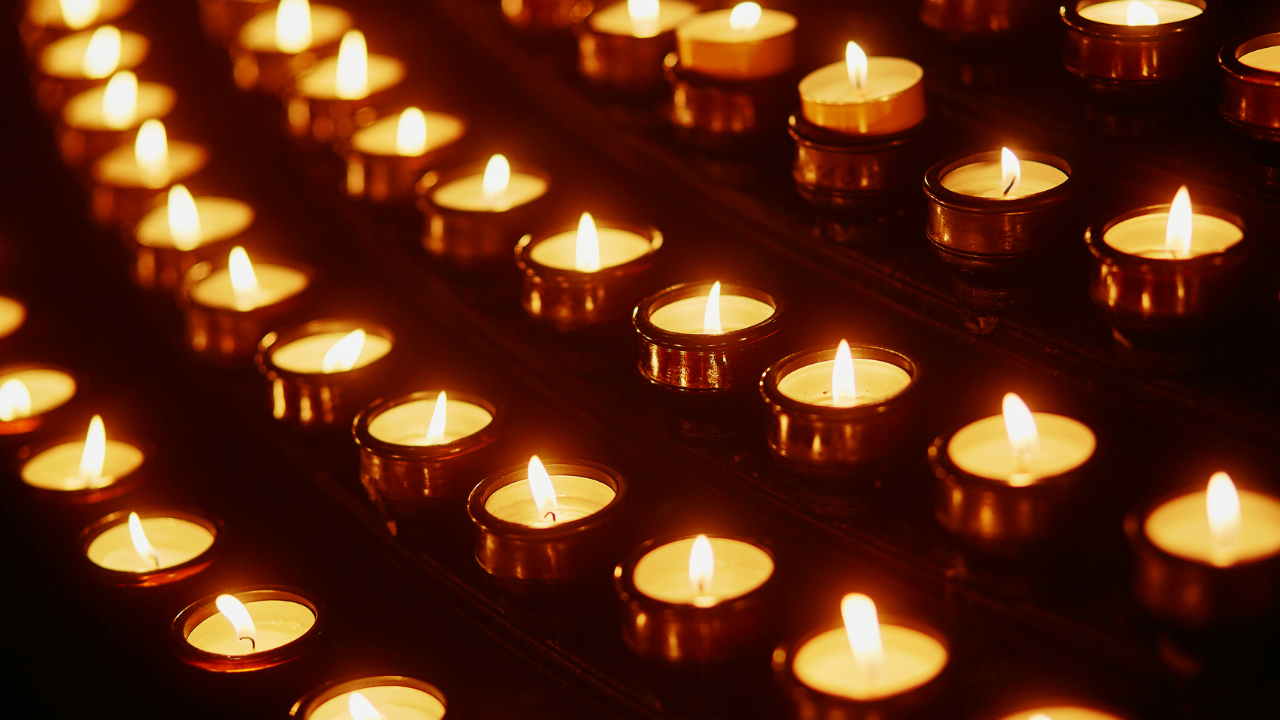No products in the cart.
The Use of Candles in Christian Worship
This post contains paid and/or affiliate links. I make a small commission at no extra cost to you. Please see our Privacy Policy.
The fascinating role of candles in Christian worship. Candles have long held deep symbolic value in religious traditions worldwide, and Christianity is no exception. In this article, we will delve into the rich history, symbolism, and traditions surrounding the use of candles in Christian worship.
Fire has always held a special significance in religious ceremonies, often representing light and righteousness. From the Hindu festival of Diwali to the eternal lamp in Jewish synagogues, fire has been revered as a symbol of divine presence. In Christianity, candles have become a powerful symbol, representing Christ’s light and God’s presence.
A journey through the historical development of candle use in Christian worship, explore the profound symbolism of candles and discover how they enhance the worship experience. We will also delve into the use of votive candles in devotional practices, and the role candles play in creating a sacred atmosphere within worship spaces. Let us unravel the spiritual significance and traditions associated with candles in Christian worship.
The Symbolism of Candles in Christianity
Candles hold great symbolism in Christian worship. They represent the presence of Jesus among the worshippers, who are often referred to as the “light of the world.” When candles are lit at the beginning of a worship service, it signifies the entrance of Jesus into the worshiping community.
The use of two candles on the altar is an everyday part of Christian worship, symbolizing the dual nature of Christ as both fully human and divine. These candles remind us of the light that shines for all people, reflecting Jesus’ role as the guiding light in our lives.
At the end of the service, the lighted candle is carried out into the world, symbolizing the mission of believers to carry forth the light of Christ in their lives and share it with others.
The Symbolic Meaning of Lighting Candles
- Represents the presence of Jesus among worshippers
- Symbolizes the entrance of Jesus into the worshiping community
- This signifies the dual nature of Christ as fully human and fully divine
- Reminds us of Jesus as the light that shines for all people
- Symbolizes the mission of believers to carry forth the light of Christ
Candles hold profound spiritual significance in Christian worship, reminding us of the symbolic presence of Jesus and our mission to spread his light. Their illumination adds to the sacred atmosphere of worship spaces, enhancing the overall worship experience.
Historical Development of Candle Use in Christian Worship
The use of candles in Christian worship has a rich history that has evolved. In the early centuries of Christianity, there is no evidence of a ceremonial use of lights. However, by the 4th century, candles had become commonplace in liturgical services. They were placed before altars and shrines dedicated to saints, symbolizing their divine presence.
During the 12th century, placing candles on altars became standard in Christian liturgical practices. The flickering flames represented the eternal light of Christ and illuminated the sacred space where worshippers gathered. This tradition continues to be embraced today.
The Blessing of Candles and Candlemas
As the use of candles in Christian worship grew, the blessing of candles became an integral part of liturgical rituals. This ritual typically occurs on the Feast of the Purification of the Virgin, known as Candlemas, which falls on February 2nd. On this significant day, candles are blessed in a special ceremony, symbolizing the purification of the Virgin Mary and the light of Christ illuminating the world.
Candles in Modern Christian Worship
Today, candles continue to hold deep symbolism in Christian worship. They mark the faithful’s prayers and represent Christ’s light, shining brightly in both individual and communal worship. Whether the soft glow of candles on the altar or the flickering flames of votive candles, their presence creates a respectful and sacred atmosphere that enhances the worship experience.
In the next section, we will explore the role of candles in worship spaces and how they contribute to the spiritual journey of worshippers.
The Role of Candles in Worship Spaces
Candles play a significant role in creating a sacred atmosphere in worship spaces. Traditionally, candles were used to illuminate worship spaces that could be dark. This allowed the presider and worshippers to see the text or music they needed to read or sing.
Over time, candles took on symbolic significance as the light of Christ. The presence of candles in worship spaces reminds worshippers that God is with them in all aspects of their lives, inside and outside the worship service.
Votive Candles and Devotional Practices
In Christian worship, votive candles hold a special place in devotional practices. These candles serve as a means for believers to offer prayers and petitions, seeking the intercession of saints. Lighting a votive candle is profoundly personal and respectful, allowing individuals to express their faith and seek spiritual guidance.
One of the unique aspects of votive candles is their association with specific saints. Depending on the saint being petitioned, the color of the votive candle may vary. For instance, candles dedicated to the Blessed Virgin Mary are often placed in blue glasses, while candles offered to martyrs may be lit in red glasses. Using different colors adds a visual element to devotional practices, reminding worshippers of the particular saint’s significance.
Using votive candles to seek intercession holds great significance in the spiritual journey of believers. It is believed that saints, who have already attained a high state of holiness, can intercede with God on behalf of those who seek their prayers. By lighting votive candles and offering their intentions, individuals express their trust in the saints’ ability to intercede and seek divine intervention on their behalf.
Through votive candles, worshippers find solace and comfort in knowing that their prayers and petitions are being presented to God through the intercession of saints. Lighting a votive candle becomes a visible representation of their faith and a tangible connection to the spiritual realm.
Benefits of Votive Candles in Devotional Practices:
- Invoke the intercession of saints
- Express faith and devotion
- Seek spiritual guidance and support
- Create a visual representation of prayers
- Provide a sense of comfort and solace
Votive candles play a significant role in devotional practices, allowing individuals to actively participate in their spiritual journey and seek the intercession of saints. The flickering flame of a votive candle is a steady reminder of the presence of the divine and the power of collective prayer.
Enhanced Worship Experience through Candles
Using candles in worship enhances the worship experience by engaging multiple senses. The soft glow of candlelight creates a peaceful and respectful atmosphere, inviting worshippers to enter a sacred space.
Candles provide visual symbolism, reminding worshippers of the presence of Christ and his light. As the flames flicker and dance, they serve as a tangible representation of the spiritual illumination that Jesus brings. The gentle glow of the candles adds a layer of beauty and serenity to the liturgical space, enveloping worshippers in tranquility and awe.
Furthermore, lighting a candle can be a tactile experience that allows individuals to engage with their faith physically. As worshippers approach the candle stand, the flickering flame ignites a sense of reverence and intentionality. Lighting a candle becomes a personal prayer as individuals quietly offer their hopes, concerns, and gratitude to God.
Senses Engaged by Candles:
- Sight: The soft, warm glow of candlelight creates a visual ambiance that helps to set the tone for worship. The flickering flames captivate our attention and let us focus on the divine presence.
- Touch: Lighting a candle allows us to connect with our faith physically. The striking of the match, the warmth of the flame, and the gentle lighting of the wick all engage our sense of touch, reinforcing the tangible nature of our worship.
Churches can create a more immersive and meaningful worship experience by incorporating candles into liturgical practices. The enhanced worship experience through candles appeals to our visual and tactile senses, helping us connect with our worship’s spiritual essence. As the candles illuminate the sacred space and evoke a sense of tranquility, they guide us toward a more profound encounter with God.
Conclusion
Candles hold immense significance in Christian worship, serving as a powerful symbol of the light of Christ and the presence of God. Candles have played a central role in liturgical practices throughout the centuries, evolving to carry deeper symbolic meanings. Their presence creates a sacred atmosphere, engaging multiple senses and enhancing the worship experience for believers.
Whether it is the lighting of votive candles or the placement of candles on altars, using candles in Christian worship is deeply rooted in spiritual traditions. The flickering flames represent the divine light that guides and illuminates the path of the faithful. The candle’s symbolism reminds us of Jesus’s presence, often referred to as the “light of the world.”
By incorporating candles into worship spaces, Christians can create a visual reminder of their faith and the teachings of Christ. The soft glow of candlelight invites worshippers to enter a respectful state, fostering a deeper connection with the divine. Furthermore, lighting a candle allows individuals to engage with their faith, reinforcing their spiritual journey physically.
In conclusion, candles in Christian worship are not just decorative elements but hold a significant role in representing the light and presence of Christ. Their historical development, symbolism, and use in devotional practices all enhance believers’ worship experience. Candles continue to serve as a tangible link to the spiritual traditions of Christianity, reminding us of the sacredness and beauty of Christian worship.
FAQ
Why are candles essential in Christian worship?
Candles hold great symbolism in Christian worship, representing the light of Christ and his presence among the worshippers. They serve as a reminder of Jesus as the “light of the world” and are used to create a sacred atmosphere.
When did the use of candles in Christian worship start?
The use of candles in Christian worship can be traced back to the early centuries of the faith. While there is no evidence of ceremonial use of lights in the early years of Christianity, by the 4th century, candles had become common in liturgical services.
How do candles enhance the worship experience?
Candles enhance the worship experience by creating a peaceful and respectful atmosphere. The soft glow of candlelight invites worshippers into a sacred space and engages multiple senses, making the experience more immersive and meaningful.
What is the significance of votive candles in Christian worship?
Votive candles are often used in devotional practices in Christian worship. They are lit to offer prayers and petitions to saints for intercession. The color of the votive candle may vary depending on the saint being petitioned.
How do candles contribute to the symbolism of worship spaces?
Candles contribute to the symbolism of worship spaces by representing the light of Christ and reminding worshippers that God is present with them. They also provide visual symbolism, reminding worshippers of the spiritual significance of their faith.
What is the historical development of candle use in Christian worship?
In the early centuries of Christianity, there is no evidence of a ceremonial use of lights. However, by the 4th century, candles had become common in liturgical services. The practice of placing candles on altars became standard in the 12th century.
How can candles be used to mark prayers in Christian worship?
Candles can be used to mark the prayers of the faithful in Christian worship. They serve as a visual representation of the light of Christ and can be lit as a way to symbolize the prayers going forth into the world.
What do candles symbolize in Christian worship?
Candles symbolize the light of Christ and the presence of God in Christian worship. They represent the spiritual significance of the faith and serve as a reminder of Jesus as the “light of the world.”
What is the purpose of the two candles on the altar in Christian worship?
The two candles on the altar often represent the dual nature of Christ as both fully human and fully divine. They serve as a visual symbol of the presence of Christ among the worshippers.











